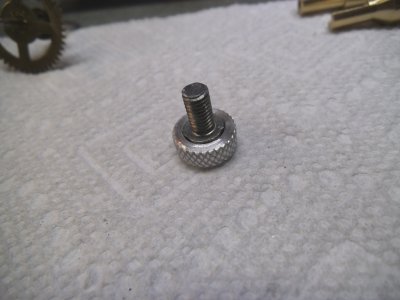I recently tried making a pair of thumb screws that used aluminum as the wheel and steel for the threaded stud. However, neither red loctite or epoxy seemed to hold really well. Is there a preferred technique or adhesive for making a permanent connection on dissimilar materials? Could it just be that I did not adequately clean the surfaces? The steel was black oxide and the aluminum was plain old 6061.
-
Welcome back Guest! Did you know you can mentor other members here at H-M? If not, please check out our Relaunch of Hobby Machinist Mentoring Program!
You are using an out of date browser. It may not display this or other websites correctly.
You should upgrade or use an alternative browser.
You should upgrade or use an alternative browser.
Thumb Screws From A Combination Of Materials
- Thread starter Ripthorn
- Start date
T
TOOLMASTER
Forum Guest
Register Today
DON'T thread the alum all the way so the stud gets tight when forced into the slightly taped part..and red locktite
- Joined
- Feb 1, 2015
- Messages
- 9,625
I recently tried making a pair of thumb screws that used aluminum as the wheel and steel for the threaded stud. However, neither red loctite or epoxy seemed to hold really well. Is there a preferred technique or adhesive for making a permanent connection on dissimilar materials? Could it just be that I did not adequately clean the surfaces? The steel was black oxide and the aluminum was plain old 6061.
Super glue or cyanoacrylate glue makes a permanent joint. Is is not as heat resistant as red LocTite but sets quickly. I used to use it on screws and nuts for production assembly and many times the screw would shear before the bond broke. I have also used it for extension drills by making an extension shank and drilling a socket for the drill bit and inserting the drill bit. I have never had one fail with this technique
Should you want to separate the two at a later date, heating with a heat gun or soaking in acetone will break the bond. You can apply on the external threads and assemble quickly or apply to the base of the connection after assembly and let it wick in. Use the water thin type.
Bob
Thanks for all the suggestions. These will be parts that won't have tons of torque, but that will also be decorative, so cross pinning is definitely out. I could probably get away with the approach of cranking the stud in since the hole will be blind and then using loctite or super glue.
- Joined
- Dec 27, 2014
- Messages
- 4,059
Loctite offers Locktite 7649 Priming liquid. The bottle says it accelerates the cure, It also may have a cleansing function. It comes in a small brown (amber) bottle with a brush.
- Joined
- Dec 27, 2014
- Messages
- 658
Red Loctite should give you a permanent bond.
You are probably just not getting it clean enough.
Try cleaning the parts with acetone and blowing them off with compressed air.
if you want to be really fussy, wear gloves. finger prints can interfere with the bond. I personally never get that fussy, I just avoid touching the parts after they are clean.
You also want to do this right away on a freshly machined surface for best results. Aluminum oxidizes very rapidly. If the parts have been sitting around for a while, clean the oxide layer off with some very fine abrasive like 3M pads or even scrape with a sharp knife.
You are probably just not getting it clean enough.
Try cleaning the parts with acetone and blowing them off with compressed air.
if you want to be really fussy, wear gloves. finger prints can interfere with the bond. I personally never get that fussy, I just avoid touching the parts after they are clean.
You also want to do this right away on a freshly machined surface for best results. Aluminum oxidizes very rapidly. If the parts have been sitting around for a while, clean the oxide layer off with some very fine abrasive like 3M pads or even scrape with a sharp knife.


